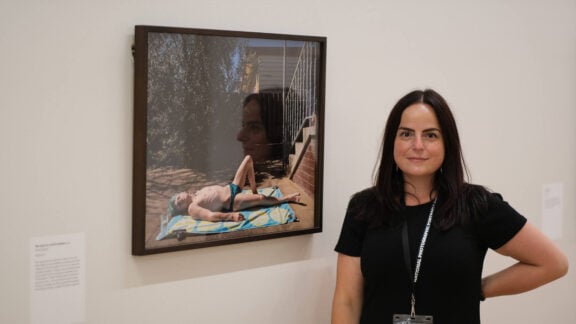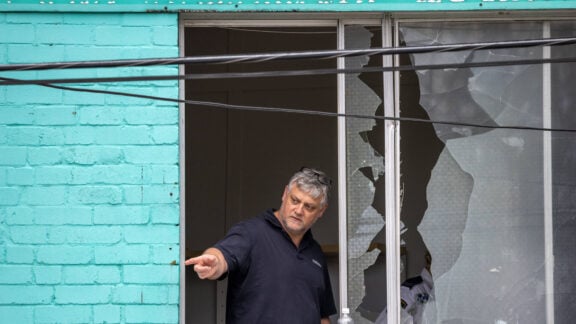The 500km walk over 20 days to return a 150kg Aboriginal stone artefact to its place of origin has generated ripples of reconciliation that the walk’s organiser, John Danalis, is still coming to grips with in the weeks that have followed.
The artefact, the Star of Taroom, is a stone with six grooves that resemble a star along which members of the Iman people would sharpen their spear and axe blades over thousands of years. It is also believed to have marked the southern boundaries of the Iman people in the Taroom region of Queensland.
Mr Danalis’ father, James, a veterinarian, saw the stone and asked the farmer on whose land the stone rested if he could have it. The farmer dislodged the 160kg stone and gave it to Mr Danalis’ father to take home and add to his collection in Brisbane.
“Dad spent a lot of time in country in Victoria, New South Wales and Queensland and he loved to collect things. He was a bit of a hoarder and our house in Brisbane was like museum of mostly pioneer artefacts. He was very proud to have the stone in the backyard, but he was no longer comfortable about keeping it,” Mr Danalis told Neos Kosmos.
It was not the first time that the Danalis family had returned an aboriginal artefact from James Danalis’ collection. Ten years ago, Mr Danalis convinced his father to return the skull of an Aboriginal woman that was part of the collection of artefacts.
“At first dad was very reluctant as he had not engaged with First Nation people before,” said Mr Danalis. His father he would be met with anger but was instead treated with kindness and respect.
“We managed to track down from which burial ground the skull had originally been taken. The journey of repatriation was a game changer for dad.”
They found through their research that the skull had originated from a Wamba Wamba burial ground in Swan Hill. The process of its repatriation is described in Mr Danalis’ book “Riding the Black Cockatoo”that he wrote 10 years ago which has published around the world. The book included in the UK school curriculum and is taught in some schools in Australia.
READ MORE: Taroom’s stolen Star returns to Iman land, expatriate John Danalis
Mr Danalis said his father had in recent years wanted to return the Taroom Stone to its rightful owners but the idea was put on hold when he was diagnosed with cancer. He was to die of it in 2019.
“The repatriation walk was done for him and to highlight to people the importance of returning stolen cultural artefacts to their original owners.
“There are many private collections that families have inherited and they do not know what to do with them,” said Mr Danalis.
The decision to transport the 160kg stone by foot (wheeled on a specially secured cart) from Brisbane to Taroom rather than drive the 500km there, was also inspired by the Ancient Greek myth of Sisyphus who is condemned to roll a big stone up a hill only for it to roll down again and for him to repeat the process eternally.
“Societies are sometimes to repeat processes (just the like the Sisyphus story), but what if we could push the Star of Taroom to the top of the hill and it stayed there?”

Mr Danalis recalled that his father, although not born in Greece himself, would read Homer to him and loved its myths and histories.
“My grandfather, Roy Danalis, came to Australia in the 1930s and worked on rural projects before opening up a cafe in Texas, Queensland which is close to the New South Wales border.
“My grandfather came from Kephalonia and he sponsored many people from the island who came to work for him and to improve their English before they set up on their own. My dad grew up in Texas and studied to be a vet. He travelled all over rural Australia,” Mr Danalis said.
The preparations for the Star of Taroom reparation walk proved long and complex. Once the decision was made for the walk, the organisers wrote to each of the traditional leaders whose lands they would cross with the stone on the way to Taroom. The cart on which the stone was to be transported was specially designed by a bicycle maker to hold its weight and keep it from being damaged during the long walk. Stonemasons and geologists were consulted, there was fundraising to be done and community awareness campaigns to be conducted.

“The history of the Iman 1850s is pretty dark and I had thought at first that there would be no Iman people ( to receive the stone) and we would be confronted with hard attitudes (from white and Aboriginal people).
“When I started making enquiries a year after dad’s death all those assumptions were blown asunder. I tracked down farmer who had helped Dad pull the stone out of his property. That farmer was on a committee helping the Iman claim their native title.”
“A core of six people walked the full distance but there were many volunteers who joined us and walked with us.
READ MORE: Greek writers at the Melbourne Writers’ Festival
We listened to a lot of stories on the way. Many white Australians came to listen and find reconciliation. Sometimes we walked in silence to listen to country and what it had to say. A lot of people compared to being on the Camino Trail, the pilgrimage trail to St Iago de Compastela in Spain. “There was wonderful fellowship. People would turn up in their utes and open the back to serve a feast for us and this had a lot of profound effect on First Nation people who recalled farmers would offer Aboriginal people poisoned cakes but now the food was offered with love.

“The walk was an opportunity for truth telling. We tapped into old Australia views where a person could talk without fear. All sorts of people joined the walk. It was a very unifying experience as Australia seems to be more divided over COVID-19,”Mr Danalis said.
Waiting to receive them and the stone at Taroom were 500 Iman people who had travelled from all over Australia to be there. Mr Danalis said that it was the biggest such meeting of the Iman since the 1850s when their world was turned upside down by white encroachment.
“Aboriginal people make good use of social media and are very active of Facebook it is used to keep the family networks strong. After we returned the skull 10 years ago, we asked them how we could keep in touch and they said ‘through Facebook’. There are 250 language groups and it is incredible who they keep in touch with Facebook,” said Mr Danalis.
He said there were a lot of parallels with Greek culture in the Aboriginal regard for family.
“The big common ground is in kinship and the family unit. What turned my father around was the respect that Aboriginal people showed for their elders, their family values and big-hearted hospitality with food and laughter.”

The stone is now housed in the Wardingarri Keeping Place which is part of Taroom Museum.
“There is a lot of unresolved business in Australia, but the walk was something that came from the grass roots and it was not an exercise that was mandated by government or academics,” said Mr Danalis.
“I got bad blisters after three days of walking and a hurt knee but the hardest part was dealing with the the emotional aspect that the walk generated,” Mr Danalis said. The walk generated massive interest in the media and there is the possibility of a documentary to follow.
“When you have done something profound, returning to normal is tough. Being on the walk was amazing – it showed me that we live within a pretty amazing and generous culture.
“I have been asked to write about the experience and I am thinking about going to country for six months to interview people for a documentary,”Mr Danalis said.
♦ For more information about the repatration walk visit The Star of Taroom website and The Star of Taroom Facebook page.










